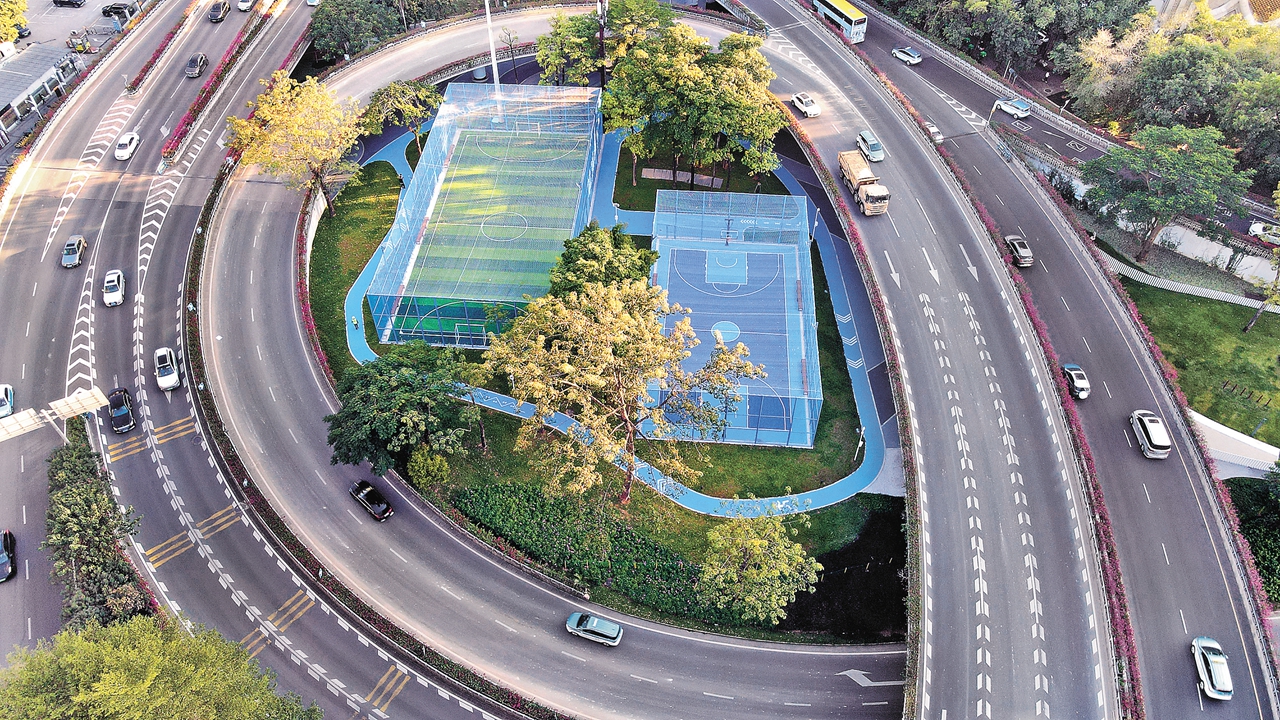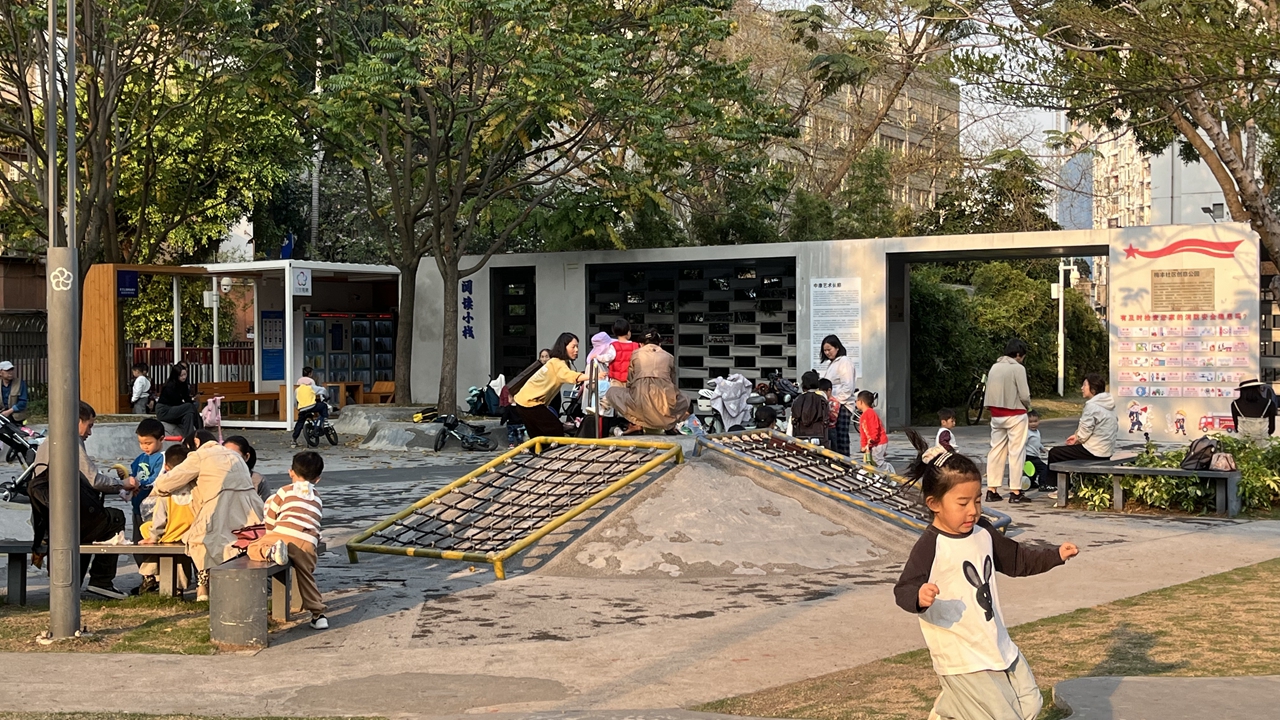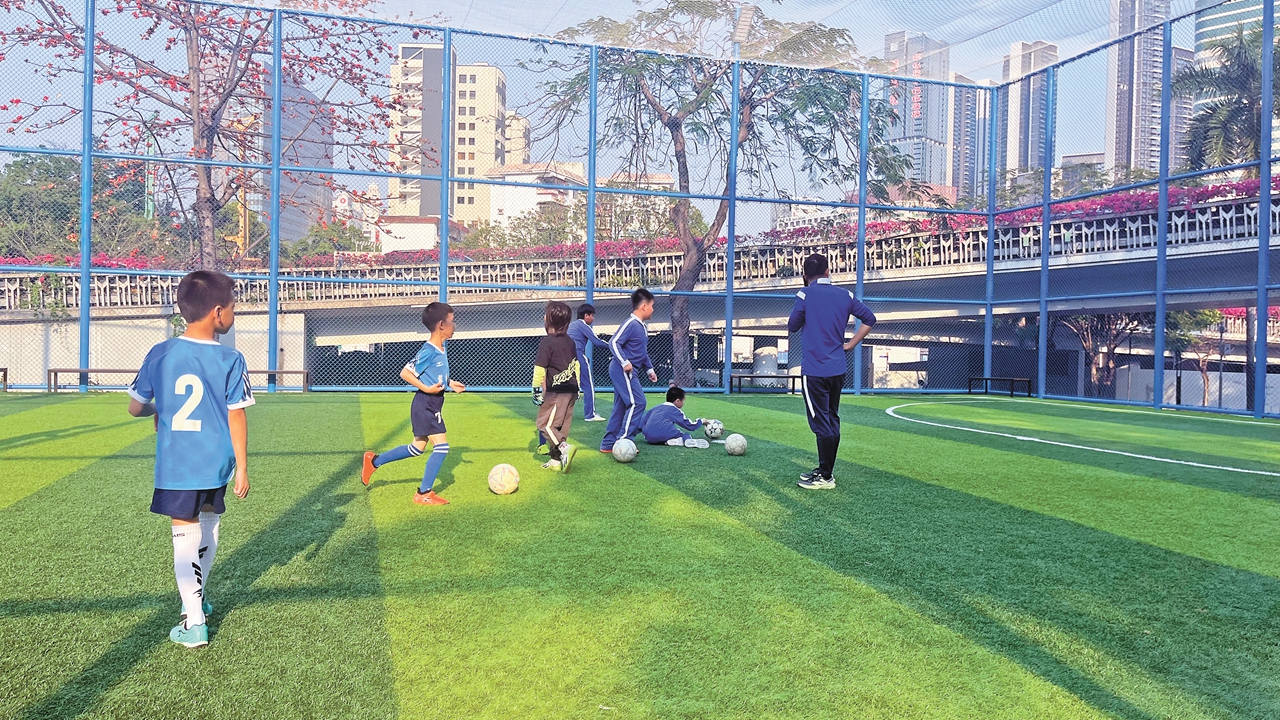Pocket parks breathe new life into urban public spaces
Writer: Wei Jie | Editor: Lin Qiuying | From: Original | Updated: 2025-03-26
With the opening of Yayuan Overpass Park on Jan. 10, residents in Luohu’s Mutoulong Community finally have a pleasant place to relax and enjoy leisurely strolls.
Previously, community residents had no access to a park within 500 meters of their homes, as many subdistricts in Luohu — one of the oldest and most densely populated districts in Shenzhen — are short of public space, making it difficult to build larger urban parks.
This 10,000-square-meter park had previously been a deserted plot of land overgrown with weeds under the Yayuan Overpass, which connects Luohu’s Dongmen, Cuizhu, and Sungang subdistricts.
After thoughtful design and renovation, this once-idle land is now equipped with various public facilities such as fitness equipment, benches, a five-a-side soccer pitch, and a basketball court.
Pocket parks
Yayuan Overpass Park is an example of the innovative, new open spaces created across Shenzhen in recent years. Also known as pocket parks, they occupy small, sometimes irregularly shaped land parcels ranging between 400 and 10,000 square meters.
 An aerial view of Yayuan Overpass Park. File photo
An aerial view of Yayuan Overpass Park. File photo
Classified as neighborhood or community-level parks, pocket parks are designed to accommodate various community activities. They also serve as tranquil retreats from the hustle and bustle of urban life, providing a place for residents to enjoy a picnic or for kids to play.
Since emerging in New York City, the U.S., in the 1960s, pocket parks have played a vital role in urban planning worldwide. They enhance the quality of life for city dwellers by providing pleasant, easily accessible green spaces amid urban chaos.
Exemplary examples of pocket parks include Greenacre Park in Midtown Manhattan, Place Dauphine in Paris, and the Royal Library Garden in Copenhagen, Denmark. Opened in 1971, Greenacre Park is a mere 18 meters by 37 meters in size but feels much larger thanks to a trellis-covered terrace that separates it from the street. The triangular Place Dauphine, nestled among quiet Parisian streets, remains one of the most popular places to visit even though it was built over 400 years ago.
Shenzhen is among the first cities in China to pilot pocket parks. In Shenzhen, they are included under the community park category — an important component of the city’s “thousand parks” initiative, which aims to provide 85% of the city’s residential areas with access to a park within 500 meters.
According to the Shenzhen Park Management Center, which aims to build 1,213 community parks by 2035, the construction of more pocket parks will address the lack of public activity space in neighborhoods.
Meifeng Community Park
Located at the intersection of Beihuan Boulevard and Zhongkang Road in the Meilin area of Futian District, the firefighting-themed Meifeng Community Park has emerged as a popular leisure destination for local residents. The park’s main highlight is a large model of a fire truck that attracts many children who are eager to climb up and explore it.

Residents have fun at Meifeng Community Park. Wei Jie
Adjacent to the park is a small fire station. It features a fire safety exhibition corridor that displays fire trucks, firefighting uniforms, and various firefighting equipment, combining fun and educational elements for the community.
Before its transformation into a pocket park, this 4,000-square-meter parcel of land, surrounded by walls, had remained desolate and unused for nearly two decades. The site briefly became a makeshift parking lot after Super Typhoon Mangkut brought down trees, causing the walls to collapse in 2018.
“What a waste of land resources in a densely populated neighborhood,” said Huang Danxia, one of the designers responsible for the Meifeng park project. She noted that the plot holds important value as it could serve as a buffer zone for the high-density area.
“A community park is a great solution for adding amenities and repurposing this otherwise blighted lot,” said she, adding that the park would provide a safe play area for children since most vacant spaces in local residential complexes are used for parking.
Huang and her team conducted surveys among local residents and developed a comprehensive plan that addressed the diverse needs of different demographic groups, including playgrounds for children, shaded seating for seniors, and green space for young people.
Liang Ruihua, another lead designer of the project, opted to design Meifeng park as a “sponge city” — an urban area designed to absorb, store, filter, and reuse rainwater, mimicking natural hydrological processes to reduce flooding and improve water management. After breaking up the original concrete pavement, they used larger concrete blocks to create a micro-topography and smaller pieces for an underground drainage layer.
The approach not only significantly reduced construction waste, but also allowed naturally growing plants to thrive in the gaps between these concrete blocks, creating a unique park landscape, said Long Xi, an architect-turned-landscape designer based in Futian.
Huang’s team added a 200-meter running loop featuring model traffic lights and mini crosswalks to teach children about traffic rules. The loop also links different areas within park, such as the children’s playground and recreational lawns. A small performance venue was also built to address the needs of different community groups.
“A low budget doesn’t mean you have to compromise on creativity or quality,” Liang said.
The park has hosted the fifth and sixth Shenzhen Public Sculpture Exhibition. Additionally, local residents have organized a variety of activities there, including free movie screenings and micro concerts. Huang said these activities exemplify the park’s value as a public space.
Public involvement in park planning
The vibrant atmosphere of Meifeng park would have been impossible without public involvement. “Without the involvement of the residents, no matter how brilliant the design of a park is, it somehow feels alienating,” said renowned architect Liu Yuyang, highlighting the importance of public engagement in the design of public spaces.
Shenzhen has taken a lead by involving residents in the co-creation of pocket parks. As early as 2019, the city’s urban management and law enforcement bureau launched the “Co-Built Parks” program, which mobilized professional architects and landscape artists, social organizations, and residents to jointly design their ideal community environments.

Students play soccer at a pitch in Yayuan Overpass Park. Wei Jie
Two years later, a guideline manual for co-built parks was compiled, outlining the work process, responsibilities of participants, and evaluation criteria for community parks.
One example is the Haibian community’s pocket park in Nanshan District. Originally an underused plot of land, this park was spontaneously transformed into a vegetable garden by community residents. However, the lack of professional planning compromised its functionality and aesthetic appeal.
Following a redesign and renovation, Haibian Pocket Park has evolved into a comprehensive green space that combines a community farm and public garden, accommodating residents’ enthusiasm for growing vegetables while incorporating features such as garden paths and resting benches. The pocket park now serves as a multifunctional place suitable for walking, community interaction, and parent-child activities.
Lianxin Garden, situated at the intersection of Qianjin and Nannong roads in Nanshan District, now boasts multiple planting zones and a floral education area, all while serving as a safe waiting zone for students attending nearby schools. The transformation happened through collaboration among students, social workers, and community residents. Previously, this area was chaotic and characterized by a mix of pedestrian and vehicular traffic as students commuted to and from schools.
Currently, Shenzhen has 583 co-built parks. Each has unique characteristics and themes, such as urban farming, flowers, and nature education. Located in the Shutianpu Community in Matian Subdistrict, Guangming District, Kaixin (happy) Park is known for an art installation based on 10 different types of happiness. Community residents collectively categorized happy emotions like warmth, understanding, and joy, and local artists then ingeniously transformed them into works of public art.
Official statistics show that 103 new co-built parks were added alongside streets and near residential communities, enterprises, campuses, and urban villages citywide in 2024. It is expected that an additional 30 pocket parks will be built this year, bringing the total number to over 600 by the end of 2025.
As a nationally acclaimed “city of parks,” Shenzhen counted 1,320 parks by the end of 2024. The creation of pocket parks has been a cornerstone in ensuring that residents have access to a park within 500 meters of their homes. As land in Shenzhen becomes increasingly saturated, developing pocket parks is a convenient and effective way to make public spaces in the city more people-oriented.